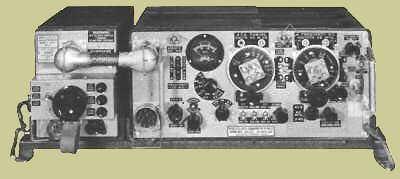BDL,
The unit on the left is the power supply, in this case a No.2, like I have here at home. It converted either 12 V or 24 V DC into 500V DC and 250V DC by using a dynamotor, a small DC motor coupled with an AC generator. The AC output was then put through a transformer to increase the tension and rectified.
The big cable delivers the high voltage power plus 12 V DC for the heating of the tubes to the tranceiver (or sender/receiver, as they used to say back then). What you don’t see in this picture is a cylindrical unit often attached to the power supply, which contains a variable inductivity to bring the antenna in resonance with the HF power ampifier in the transceiver.
If you look at the transceiver, the right hand side are the controls for the HF set, especially the two big, round indicators for the tuning frequency (behind each is an adjustable capacitor, if I have a bit of time, I’ll take some pictures of the insides of my radios and post them), one for tuning both the receiver and transmitter circuits and one for the power amplifier.
Beneath the lefthand tuning wheel are three switches to switch the intercom, the VHF radio and the HF radio seperately on and off. The gauge is voltmeter / amperemeter used to check both the voltages from the power supply as well as the voltage and current output at the antenna to adjust the set properly. It also has a selector to select between the different modes of modulation, CW, MCW and R/T (AM voice).
To the left of the gauge is a small dial, which controls the tuning of the VHF set.
Audio frequency output came from the lower big socket on the tranceiver. Usually it would be connected to an intercom box, which provided jacks for microphones and headsets (different versions depending if the wireless set was being used alone or in a tank, where it acted as intercom as well). The morse key was plugged into a small jack right beside the output socket.
BTW, I’ve got one set working as a receiver. Since I don’t have an amateur radio operator licence yet, I didn’t try the transmit functions, but I received commercial radio broadcasts from Canada last night, loud and clear, also CW transmissions by radio hams in the 40 and 80 meter band.
I was using a simple 6 meter CB radio antenna, not a proper antenna for the frequencies required.
Jan

